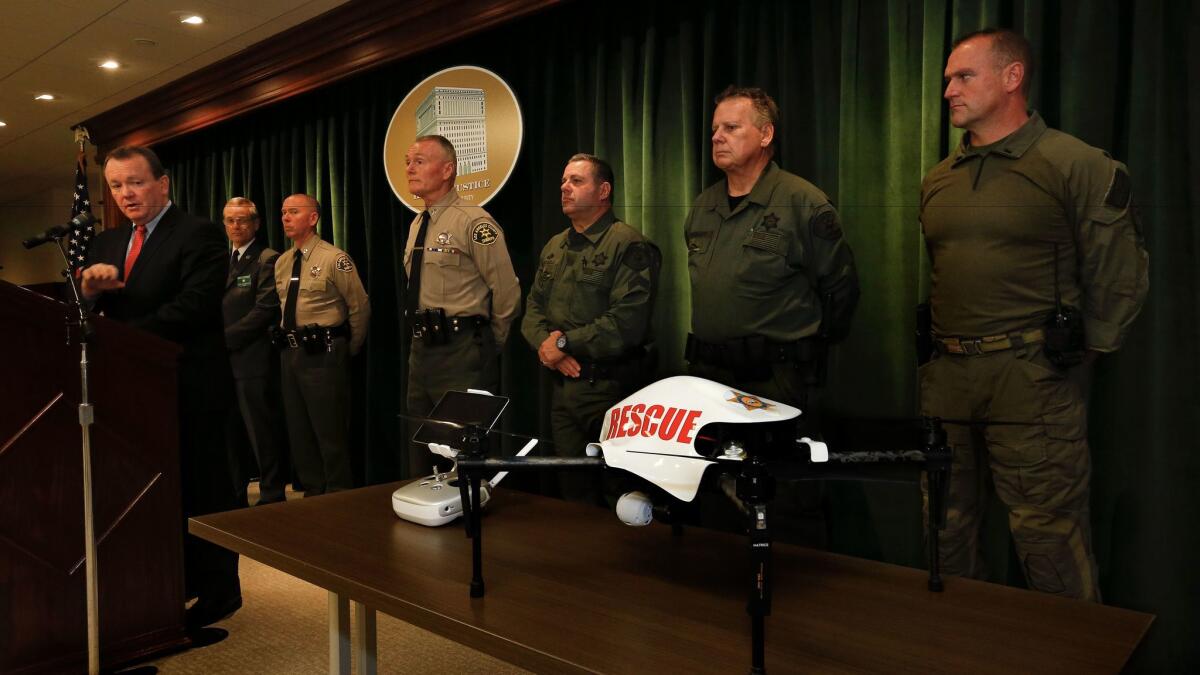L.A. Sheriff’s Department to begin using drones to respond to bomb threats, hostage crises

Los Angeles County Sheriff’s Department’s new drone. (Mel Melcon/Los Angeles Times)
- Share via
Los Angeles County Sheriff Jim McDonnell said Thursday that his agency will begin deploying an unmanned aerial device to aid deputies responding to arson scenes, suspected bombs and hostage situations, but he promised the device would not be used to surveil residents.
The use or attempted use of drones by law enforcement elsewhere has come under fire from privacy and civil liberty advocates, and McDonnell and other agency officials avoided using the word “drone” during a 20-minute news conference unveiling the department’s latest technological addition.
Instead, the sheriff praised the $10,000 device as a useful tool that can give deputies a life-saving advantage in potentially deadly situations.
“The dangers of law enforcement can never be eliminated,” he said. “However, this technology can assist us in reducing the impact of risks on personnel.”
Eight deputies have been trained to fly the device, according to Capt. Jack Ewell of the department’s special operations bureau. The device can remain in the air for 20 minutes and fly up to a mile from the deputy controlling it; but under Federal Aviation Administration rules, Sheriff’s Department personnel must maintain visual contact with the device while flying it, Ewell said.

McDonnell said the drone could provide deputies with critical information from previously inaccessible vantage points when dealing with a barricaded suspect or searching for a missing person lost in treacherous terrain, such as a canyon pass.
The FAA has issued 300 “certificates of authorization” to U.S. law enforcement agencies, allowing them to use similar devices, according to McDonnell. Thirty such certificates have been issued in California, he said.
Under the agreement, sheriff’s officials have to notify the FAA anytime the drone is airborne, and provide information about where it will be flying and for what purpose, Ewell said. The Sheriff’s Department had to submit a list of tasks the drone would be used for, and that list does not include surveillance, according to Ewell.
“The [unmanned aircraft system] will not be used to spy on the public,” McDonnell said, repeating the promise several times. “Our policy forbids using [it] for random surveillance.”
Ian Gregor, a spokesman for the FAA, said any agreement between his agency and the Sheriff’s Department would not actually govern how police use the device.
“We don’t prohibit the type of flight activity that a law enforcement agency conducts,” he said via e-mail. “We do have limitations on the conditions under which a drone can fly.”
Civil liberties advocates and local activists have long expressed concern that police might use drones to conduct warrantless surveillance. A bill that would have required police in California to obtain a court order before using drones for surveillance was vetoed by Gov. Jerry Brown in September 2014, a decision that came after concerns were raised about a plan by the LAPD to use drones.
Protesters descended on City Hall after the LAPD announced it had received two drones from the Seattle Police Department, which itself chose not to employ the devices in response to public criticism.
Since then, the devices have gone unused and remain in the office of the LAPD’s inspector general, according to Capt. Andy Neiman, the department’s chief spokesman.
There have been no discussions about deploying the drones in the near future, but Neiman said they could prove extremely useful to officers when dealing with heavily armed suspects.
He pointed to the hunt for the husband and wife who carried out the 2015 San Bernardino terror attack as a prime example of a situation where drones could have helped officers. After a gunbattle with the attackers, law enforcement officers had to risk their lives by approaching the couple’s car to confirm whether they were dead or still posed a threat.
“Rather than sending live human beings up to see what they were doing in their vehicle, you could have sent a drone up there to see what their status was,” he said. “Are they armed? Do they have a bomb on them?”
The Sheriff’s Department has been criticized for large-scale surveillance in the past. In 2012, a single-engine aircraft spent nine days circling Compton, recording low-resolution images of the city. Compton officials were not notified of the surveillance, and when the program came to light in 2014, several residents, including Mayor Aja Brown, expressed dismay.
Adam Schwartz, a senior staff attorney with the Electronic Frontier Foundation in San Francisco, criticized the Sheriff’s Department for not holding a public meeting on the use of the drone before deciding to employ it.
“What we see here is a unilateral decision of police executives as opposed to the community as a whole,” he said. “We think the process here is upside down.”
He also expressed concern about potential “mission creep” in the department’s use of drones. Law enforcement’s use of the technology, he said, can become more invasive over time to include such activities as monitoring protests, which could have a chilling effect on free speech.
“We’ve heard a million times that a tool is acquired to do one thing, and then it’s used to do the next thing,” Schwartz said. “We are very concerned that whatever the rules are now, with the stroke of a pen, they get deployed to some new and more disturbing purpose.”
Follow @JamesQueallyLAT for crime and police news in California.
ALSO
67 arrested in crackdown on San Bernardino County gangs
Call it the Southern California drought. Rain and snow end Northern California water woes
LAPD’s watchdog rolls out smartphone app to share more information with public
More to Read
Sign up for Essential California
The most important California stories and recommendations in your inbox every morning.
You may occasionally receive promotional content from the Los Angeles Times.











